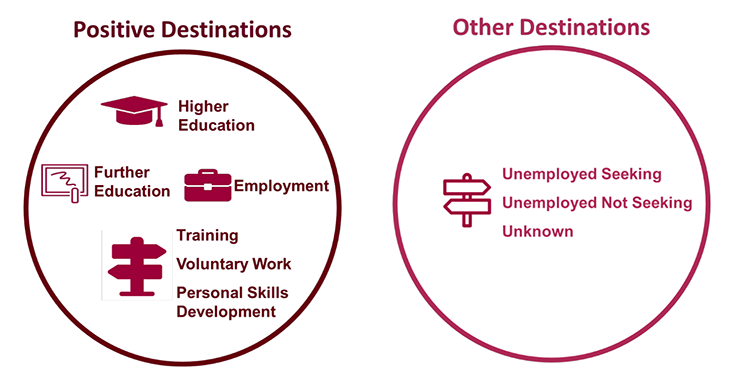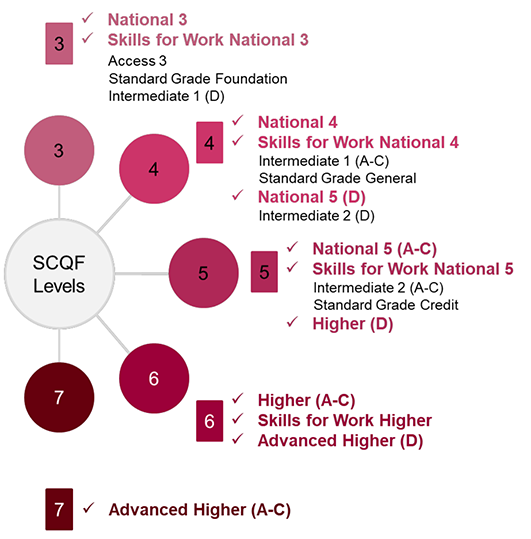Summary Statistics for Attainment and Initial Leaver Destinations, No. 5: 2023 Edition
This statistical publication provides information on the educational attainment and initial destinations of 2021/22 school leavers from publicly funded schools in Scotland.
Chapter 1: Introduction
This chapter outlines data sources, concepts and methodology associated with the data used in this report and provides information on the impact of the coronavirus (COVID-19) pandemic on these statistics.
1.1 School Leavers
A school leaver is defined as a young person of school leaving age, who left during or at the end of the school year. For 2021/22 school leavers, the leaver year is 15th September 2021 to 13th September 2022.
This publication covers school leavers from all stages of secondary school. For most young people, S4 (15-16 year-olds) is the last compulsory year of school, but the majority choose to stay on and complete S5 (16-17 year-olds) and S6 (17-18 year-olds). Please note pupil ages are based on approximate age ranges; more information is available from the pupil census supplementary statistics.
Figures in this report are based on pupils in publicly funded mainstream schools, in the 32 local authorities and one grant aided school. Figures including school leavers from publicly funded special schools are available in the supplementary tables.
1.2 School Leaver Destinations
This publication provides information on the initial destinations of 2021/22 school leavers, relating to outcomes approximately three months after the end of the school year (3rd October 2022).
A separate publication - 'Summary Statistics for Follow-up Leaver Destinations' – will follow in June 2023 and will provide information on the follow-up destinations of 2021/22 school leavers, approximately nine months after the end of the school year (1st Monday in April 2023).
School leaver destinations data is based on the Skills Development Scotland (SDS) 'Opportunities for All' shared dataset, matched with pupil census records for the school year 2021/22. More information can be found in section 7.2.1.
Destinations are grouped in the following categories within this statistical bulletin:

1.2.1 Impact of the coronavirus (COVID-19) pandemic on School Leaver Destinations
The time series presented in this publication includes years where school leaver destinations have been affected – either directly or indirectly – by the coronavirus (COVID-19) pandemic. The impacts of COVID-19 should therefore be kept in mind when considering changes over time in school leavers' destinations.
The greatest effect of the pandemic on school leaver destinations is likely to have been seen in 2019/20. However, it is likely that there has been some ongoing impact on the destinations of some 2020/21 and 2021/22 school leavers. One reason for this may be the effect of different approaches to certification of SQA qualifications in 2020, 2021 and 2022 on pupils' attainment. The pandemic may also have influenced some pupils' decisions on when to leave school.
Further information on the impact of the coronavirus on these statistics can be found in section 7.6.
How can I use School Leaver Destination figures?
Do use School Leaver Destination figures:
- as an accurate reflection of school leavers' initial destinations
- to compare the destinations of different groups of school leavers
- to make comparisons over time of the destinations of school leavers – whilst bearing in mind the impact of COVID-19.
Do not use School Leaver Destination figures:
- without considering the impact that COVID-19 may have had on the availability of particular opportunities in certain years.
1.3 School Leaver Attainment
Within this report, the main school leaver attainment data found in Chapters 4 and 5 covers Scottish Qualifications Authority (SQA) National Qualifications achieved throughout all stages of a pupil's education at school. The range of qualifications included can be found in the diagram below, and cover National Courses (such as National 5, Higher and Advanced Higher) as well as Skills for Work courses. The main statistics on National Qualifications do not include attainment in National Units, Scottish Baccalaureate or National Qualifications below Scottish Credit and Qualifications Framework (SCQF) Level 3 (such as National 1 and National 2). Plans to cover a wider range of qualifications in future are outlined in section 7.3.1.
The Scottish Credit and Qualifications Framework (SCQF) is used as the basis for reporting attainment. The SCQF is Scotland's national qualifications framework which allows broad comparisons to be made between qualifications at a similar level of difficulty. The SCQF level indicates the level of difficulty of a particular qualification. It allows learners, employers and the public in general, to understand the range of skills and learning that should be achieved at each level.
This publication reports the number of passes at a given SCQF level or better and the highest SCQF level achieved at SCQF Levels 3 to 7, incorporating the National Qualifications shown in the following diagram.
Qualifications included in the main measures within this publication:

(Current qualifications are marked with a tick ✓)
The publication uses the 'latest and best' approach for attainment data. This means that only the best result within a subject is counted. For example, if a pupil passes Higher Mathematics one year and Advanced Higher Mathematics the following year, only the Advanced Higher qualification will be counted when looking at how many qualifications at any level that leaver has achieved, by the time they left school.
In this publication, grade A to C (or ungraded pass) is considered a pass. If a pupil attains a grade D at any of these levels, this is counted as equivalent to a pass at the level below.
Highers (SCQF Level 6) are generally taken in S5 or S6 and Advanced Highers (SCQF Level 7), are generally taken in S6. Highers, sometimes along with Advanced Highers, are typically the Scottish qualifications required for entry into Higher Education.
School leavers from 2021/22 will have experienced the Curriculum for Excellence (CfE) throughout the entirety of the senior phase (S4-S6) of their school education. School leavers from 2013/14 and 2014/15 will have taken a range of awards and qualifications, including both current qualifications and older qualifications that have now been phased out. Using SCQF levels to measure attainment in National Qualifications allows for broad comparisons between qualifications to be made consistently over time.
More information can be found in section 7.2.2.
1.3.1 Impact of the coronavirus (COVID-19) pandemic on School Leaver Attainment
The coronavirus (COVID-19) pandemic led to changes to the way in which National Qualification results at SCQF Levels 5 to 7 were determined. The attainment data in this report considers all of the attainment which a school leaver gains over their time at school. This means the attainment of school leavers in 2019/20, 2020/21 and 2021/22 may be based on a combination of different approaches to determining results.
The coronavirus (COVID-19) pandemic led to the cancellation of 2020 and 2021 National 5 (SCQF Level 5), Higher (SCQF Level 6) and Advanced Higher (SCQF Level 7) exams and alternative approaches were taken to determining grades. In 2020 grades were determined based on teacher estimates. In 2021 teachers and lecturers used their professional judgement of a learner's demonstrated attainment to determine results in line with subject-specific guidance. In 2022, there was a return to the use of exams. These were supported by a package of measures such as course modifications and revision support, which were designed to address the ongoing disruption to learning and teaching which young people had experienced, while maintaining standards. In addition a more generous approach to grading was adopted to help ensure fairness for learners. The approaches taken to determining results in 2020 and 2021 saw pass rates in National Qualifications increase. The approach taken in 2022 resulted in pass rates decreasing from those levels, although they remained higher than pre-pandemic levels.
School leaver attainment statistics do not always follow the same pattern as National Qualification results in a given year. This is partly because school leaver attainment statistics cover attainment over several years, and also because not all pupils who sit National Qualifications in any given year leave school in that same year. However, the likely impact of the changes to how results were determined from 2020 to 2022 would be increased levels of school leaver attainment in 2019/20 and 2020/21. Whilst for 2021/22 school leavers we might expect that attainment levels would remain higher than before the pandemic but be lower than for the 2019/20 and 2020/21 school leavers.
The attainment data in this report provides an accurate reflection of the attainment with which school leavers in Scotland left school; for this reason attainment data for 2021/22, 2020/21, 2019/20 and previous years are presented together. However, a dashed line break in the series has been placed between 2018/19 (and before) and 2019/20 (and after). This indicates that the attainment of school leavers in 2019/20, 2020/21 and 2021/22 has been determined differently to that for 2018/19 and before and that care should be taken when making comparisons over time.
Also, as reported in last year's publication the size and make-up of the leaver cohorts in 2019/20 and 2020/21 indicated that some pupils may have chosen to remain at school for an additional year as a result of the pandemic, leaving in 2020/21 rather than in 2019/20. For some pupils this may have influenced their total attainment while at school. It is another reason why care should be taken when comparing school leaver attainment figures in 2019/20, 2020/21 and 2021/22, and to pre-pandemic years.
Further information on the impact of the coronavirus on these statistics can be found in section 7.6.
How can I use School Leaver Attainment figures?
Do use School Leaver Attainment figures:
- as an accurate reflection of the attainment with which school leavers in Scotland left school in different years
- to make factual comparisons of the proportions of school leavers attaining at different SCQF levels over time
- to compare the attainment of different groups of school leavers within years.
Do not use School Leaver Attainment figures:
- as an indication that performance in 2019/20, 2020/21 or 2021/22 was better or worse than in previous years, without further evidence
- without taking full account of the different approaches to certification in 2020, 2021 and 2022 compared to previous years.
1.4 Additional Qualifications
Whilst the main measures in this report focus on National Qualifications, Chapter 6 covers other qualifications that pupils may leave school with. Chapter 6 covers:
- Attainment statistics relating to vocational qualifications associated with Developing Scotland's Young Workforce (section 6.1).
- Experimental Statistics on Foundation Apprenticeships (section 6.2).
- Experimental Statistics covering a wider attainment measure incorporating all SQA qualifications (section 6.3).
Experimental Statistics are new Official Statistics that are undergoing evaluation. Further information on the reasons for publishing these new figures under this status are presented in sections 6.2 and 6.3.
Contact
Email: school.stats@gov.scot
There is a problem
Thanks for your feedback